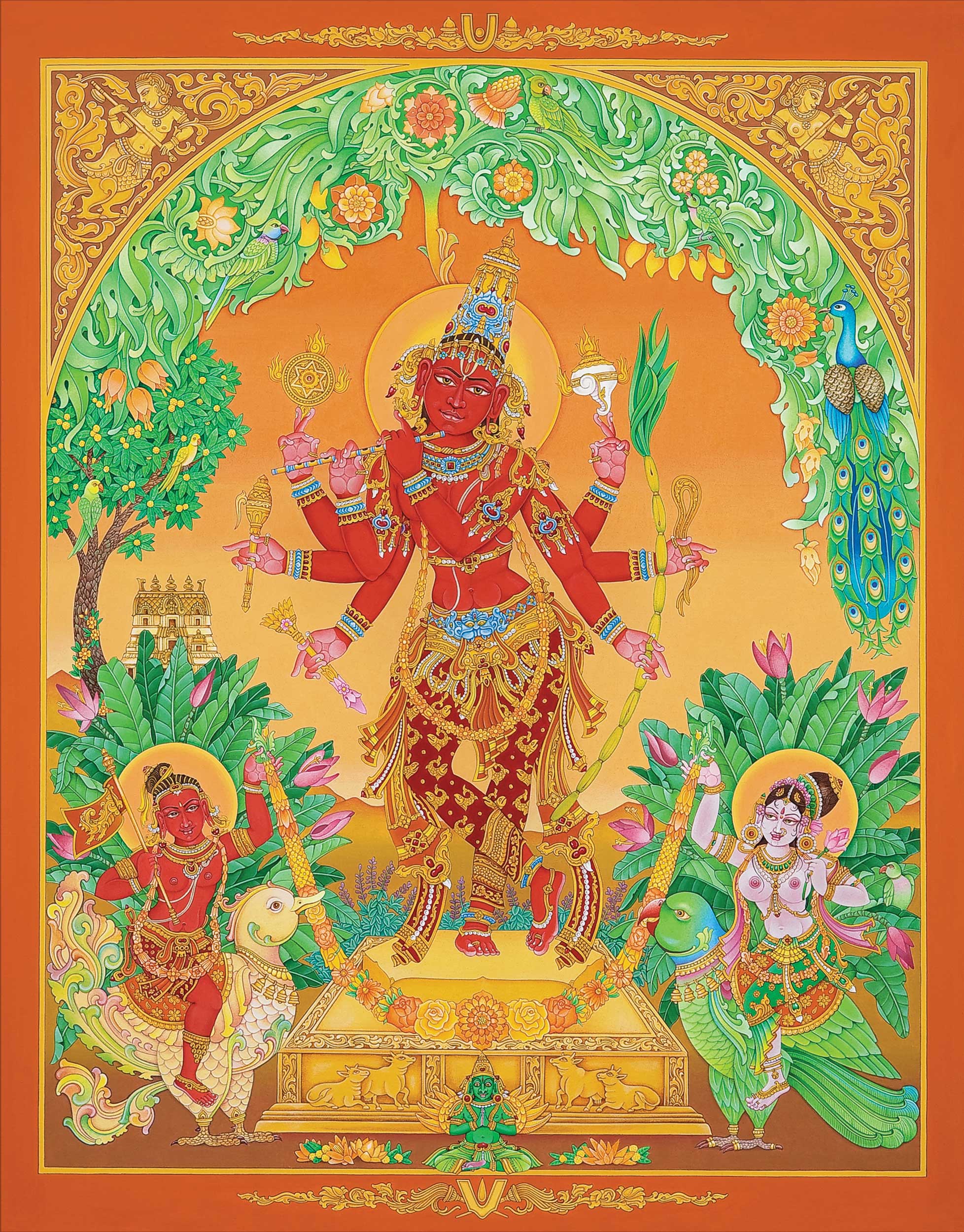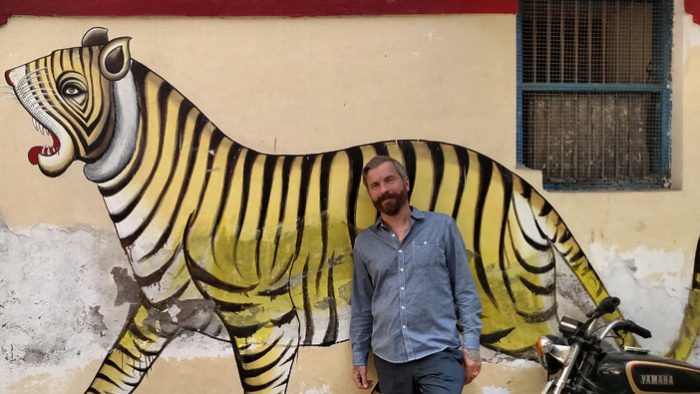Narasimha or Nara (Marcus Allsop) is a difficult artist to track down. He resides in rural Arizona where he helps facilitate a retreat center by cooking, chanting and meditating. He spends long periods in India engaging with deities, which he says are as “real as us”. He has been painting deities for over 20 years and travels to India for darshan; seeing and being seen.
“Initially we may see the deity as being separate from us but they are arising from the One common source of Being we all share and therefore are in no way separate or different from us – ultimatey. The images inspire and bless when viewed correctly,” says Nara.

In a beautiful conversation with CSP, Nara talks about his journey and inspiration.
The sculptor or artist in the Indian tradition didn't aspire to stand out or draw attention to himself. They were part of a parampara and followed the agamas. How does this work ethic fit in with Western notions of art and the artist?
If it is only a matter of following the agamas then we have a correct agamic form but crucially do we have magic? We need a training and then we have to conjure the Spirit so that what we produce is really the best kind of offering. Something with juice! The artist, in a parampara or not, still needs to find themselves as a vehicle for expressing profound presence and tradition absolutely serves this purpose and concurrently can limit. This rub of tradition versus individual expression goes a long way in refining the artist.
Western art is of course many varied things but certainly the artist is primary, but we cannot compare mangoes to cheese. They are too different. Yet we can look at the great Cathedrals of Europe and see wonderful anonymous art in profusion in a manner that is not so different from the traditional Indian way of approach. It is only when we come to modern art that comparisons break down.
Just as orthodox religion still throws up the occasional great Guru or Saint so too orthodox artistic tradition also throws up the occasional great artist. The one who breathes life into the stone. It's debatable whether that particular quality can ever be taught. I am sure that India has had more than a few artists whose vision placed their work in a category that brought renown. That said, tradition is invaluable for an almost infinite array of reasons. It is the basis for discovering that which goes beyond the tradition itself. And that is what the art alludes to.

Yoga Hanuman by Nara
When did you first come to India? What was your experience?
I arrived in India for the first time on Diwali 1989. It was a difficult time in my life as my parents had just been through an acrimonious divorce and I was deeply disappointed by that. I was 21 years young. I remember being thoroughly incapable of communicating effectively with the amazing people of India, as though they were living on a different frequency entirely to me. This was accurate! People were inquisitive and gracious but I was painfully shy. Still something a little odd happened that made me feel more alive and that was that every time I saw an image of Shiva, Ganesha, Devi or Krishna they seemed like living beings. Alive and capable of transmitting light, joy, energy. In short I was consistently captured by their presence and spiritual power. Who they were and who I was in relationship to them became instantly my overwhelming obsession, interest and concern. I was an intense young man, to put it mildly, and I was very touched by what I perceived of the Deities kindnesses. So much so that I thought it must be the most wonderful thing in the world to paint them as an honouring of what I could perceive of their Reality. I never imagined I would spend the rest of my life doing this but that's what happened. The Gods of India offered me relationship at a time when it seemed like my other relationships had failed.

Madana Gopala by Nara
What do Shakti and Devi mean to you? How do they inspire you, operate through you?
Shakti and Devi mean the grace of the transcendent transmitted into the here and now through the agency of all that surrounds us. Also the mystery of the turning of our attention to the Divine. At the right time the feminine force of absolute love pushes us more and more to Her grand perspective. Devi owns us, Shakti animates us.
The forms of Deity inspire through the innate force of attraction that Devi possesses and the more we can relax into that attraction the further attracted we will be! That's really good news. A passionate interest is required to garner Devi's response, later we can be initiated into Her qualities of dispassion. When we mature. For now we can admire and supplicate the wonderful form knowing ultimately that to surrender to Her means the death of ignorance. Hence the slaughtered buffalo demon being the conquering of our tamas and rajas.
How did Robert Beer's work and training change you?
Meeting Robert Beer was a wonderful experience, he is an exceptional talent. He taught me to look and to see what was great about a painting. He exhibited kindness, patience and great generosity so those very warm qualities helped me through my akwardness as a beginner. That said, he did move without telling me where he was going at one point in my training and I had to hunt him down! I did not spend much time with Robert but what time I had with him was potent. It was only after training with Robert that I began to find my own style due to the overwhelming impact Vijayanagara temple sculpture had on me. The line is so different than in Tibetan art! More recently I have been enjoying the influence of late Pahari painting. I don't care so much about an artistic continuity in my work, what matters is that in each painting the Deity is joyously represented. I am painting for lovers of God, not for any kind of scene. Going back to Robert it was his example that changed me, he followed a great tradition but was innovative and did things his way. Always with immaculate precision!
As an artist what inspires you about the temples of South India. They were conceived with great precision...with both science and art in mind. Do you believe in art being intuitive or constructed?
The grand temples of South India really are one of the true wonders of the world. Aside from the spectacular scale the sculptures are very often of great quality and superbly situated. They express a vast effusion of creativity and bring joy to the viewer. That alone is worthy but they also inspire devotion to God and provide space for both community and contemplation. All of this is a magnificent achievement and something all Indian people can be rightly proud of. The iconography resonates with a longing to reunite with the source of ourselves. As sacred environments everywhere are encroached upon these huge temples will be ever more important for those of us tired ones seeking peace and sanctuary from the frenetic pace of human society. There we can let our minds subside and we can bathe in impressions of the sacred. The great Alvar and Nayanar Bhaktas went into rapture at so many of these wonderful shrines - we should try too!
I believe that first comes intuition and then comes construction! Or inspiration then perspiration as we try to do justice to what we or our culture has intuited. But whether art is intuitive or not it should be good!
You speak about having visions of Kali. It was something many great composers and artists experienced. How does one reach that space of connecting with the divine? Does Yoga and meditation help?
Yoga and meditation help those that are ready for them! However the path manifests in mysterious ways and ones yoga may be something very unique to the individual. I really believe anything can be a yoga if done with sincerity and a relaxed open mind. It has been my experience that visualizing the Deity in the heart space with patience and relaxation is of great use. Whatever it is we do in the name of connecting with the Divinity, it is to make us sensitive and receptive to highly subtle energy and refined feelings. So if you can find something that does that for you then it is a good yoga or meditation for you. Force and rigidity will not help, though quiet dedication is golden.
Also you can hold the hand of one of the great ones whose oneness with God makes their contact highly auspicious - Anandamayi Ma, Sarada Devi and Sri Ramakrishna, Ramana Maharshi, Bhagavan Nityananda of Ganeshpuri, Meher Baba and more all have extraordinary highly impressive dharma and blessing force. I don't know so much about the modern manifestations!

Simha Ganapathi by Nara
What do you think India offers to the world?
Definitely her arts. I have been drinking from that reservoir of inspiration my entire adult life, and still I find things that surprise and delight me. Most recently the vigorous wall murals of Bundelkhand. I am so thankful for that. Sadly much has gone - I truly miss the slowness, it had grace and depths that one could sink into. India has given so much light from the spiritual domain and where would we be without Indian music, culinary arts, painting, textiles and thought? A less magical place for sure.
I feel indebted to her mystical heritage that has supported me till now. Particularly the teachings of Advaita, probably most accessible to modern people through the words of Nisargadatta Maharaj and Ramana Maharishi. They shine such a light on how to take advantage of this precious, complex life. And we haven't even gotten to the Bhakti traditions that are so elevated and rich - the wonders of Sri Vallabhacharya and the unparalleled transmission of the Pushti Marg. So much greatness! So much sweetness!
India is an invitation to dive into exalted perspectives and be forever changed.

(Nara's latest picture of Hanuman (completed a couple of weeks ago) is available for sale through Vigraha Gallery: www.vigrahasacredart.com, Email: vigrahasacredart@gmail.com)





